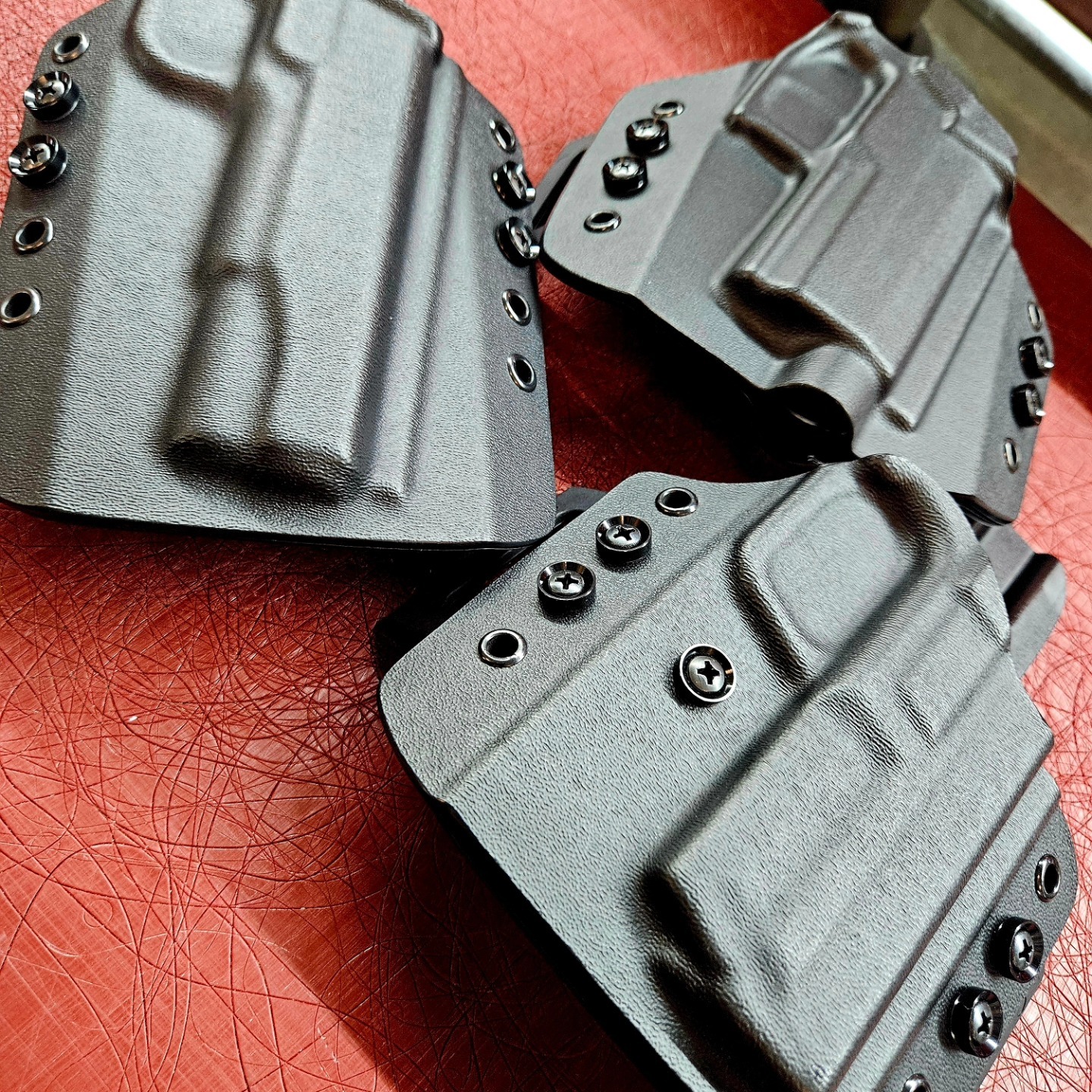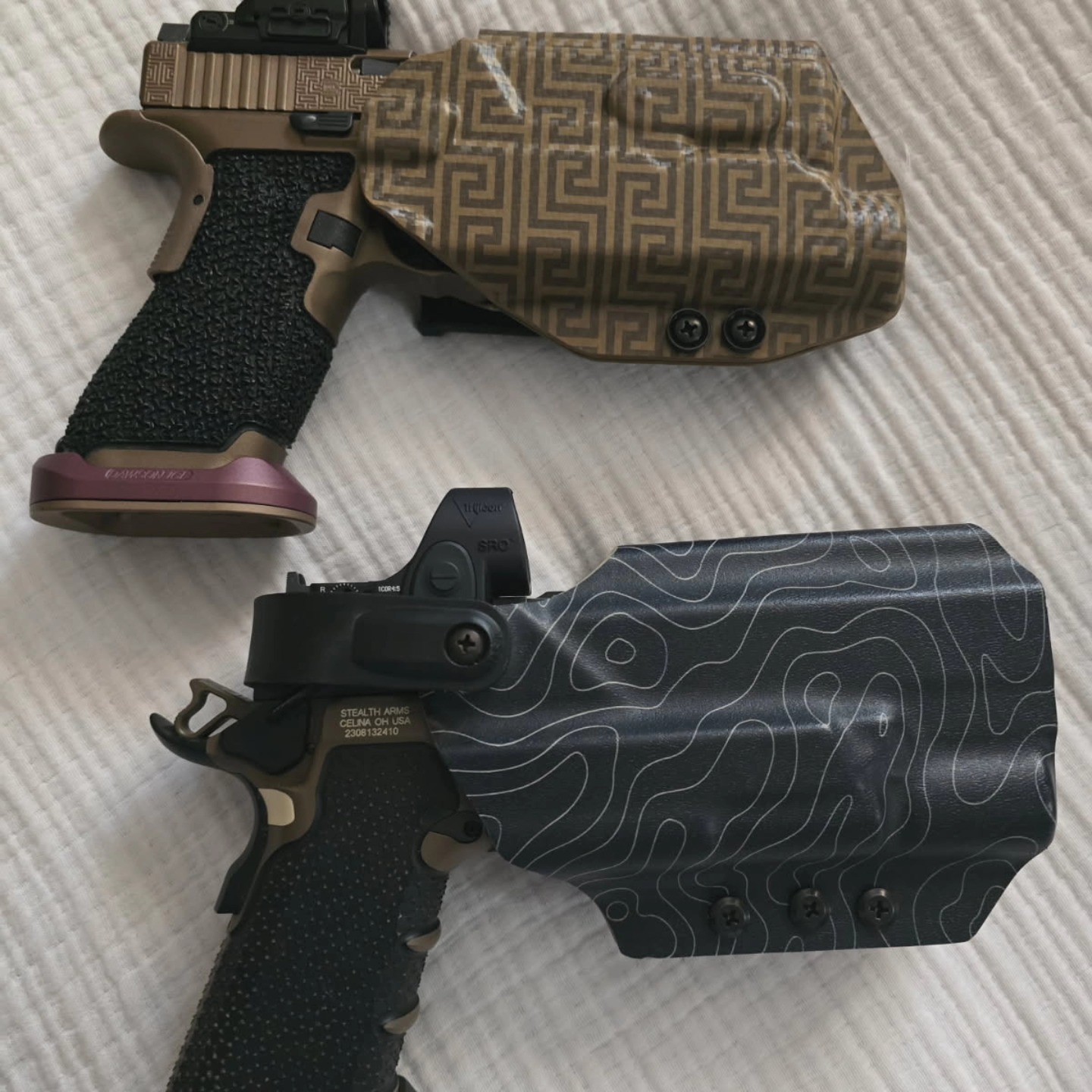Concealed Carry vs. Open Carry
Sep 22nd 2025
Which Is Right for You?
Carrying a firearm for personal protection is a serious responsibility, and it seems as though more and more people are starting to do it each year. If you are considering carrying a gun, one of the first decisions you’ll need to make is whether to carry concealed or open carry. Each method has its advantages, legal considerations, and practical implications. Understanding the differences between concealed carry and open carry is essential for anyone looking to carry responsibly and confidently.
Our team at Bucks Holsters is going to break it down.
What Is Concealed Carry?

Concealed carry refers to carrying a firearm in a way that is hidden from public view. This typically involves holsters that can be worn inside the waistband (IWB), on the ankle, or in a purse or bag. The goal is to keep the weapon discreet while still having quick access if necessary.
Advantages of Concealed Carry
-
Discretion: Concealed carry allows you to carry a firearm without drawing attention. This can be useful in professional settings or public spaces where an openly displayed weapon might cause alarm.
-
Surprise Factor: In a self-defense situation, a concealed firearm gives you an element of surprise over potential attackers.
-
Legal Flexibility: Many states have specific regulations that make concealed carry more straightforward in terms of where you can legally carry.
Challenges of Concealed Carry
-
Accessibility: Drawing a concealed firearm quickly can be more challenging, especially from certain types of clothing or holsters.
-
Comfort: Carrying concealed for extended periods can sometimes be uncomfortable, depending on your clothing and body type.
-
Training Requirement: Concealed carry demands consistent practice to ensure safe, efficient, and legal deployment in an emergency.
What Is Open Carry?
Open carry is the practice of carrying a firearm in plain view, usually in a shoulder holster, hip holster, or chest rig. Open carry is legal in many U.S. states, though the laws vary widely regarding permits, types of firearms, and locations where open carry is allowed.
Advantages of Open Carry
-
Deterrence: Visible firearms can act as a deterrent against crime. Many people avoid confronting someone openly carrying a weapon.
-
Quick Access: Open carry allows for faster draw times since the firearm is immediately visible and accessible.
-
Comfort: Some shooters find open carry more comfortable than concealed carry, especially when carrying larger firearms.
Challenges of Open Carry
-
Public Attention: Open carry can attract unwanted attention from both civilians and law enforcement.
-
Social Stigma: In some areas, open carry is frowned upon or can create tension in public spaces.
-
Legal Restrictions: Open carry laws vary by state, and some locations like schools, government buildings, and private businesses may prohibit openly carried firearms.
Concealed Carry vs. Open Carry: Key Differences Checklist
When deciding which method works best for you, consider these key points:
-
Visibility: Concealed carry keeps your firearm hidden; open carry makes it visible.
-
Accessibility: Concealed carry may take slightly longer to draw; open carry provides immediate access.
-
Legal Requirements: Concealed carry usually requires a permit; open carry laws differ by state.
-
Deterrent Effect: Concealed carry offers limited deterrence; open carry can discourage potential threats.
-
Social Acceptance: Concealed carry is often more accepted in urban settings; open carry can attract attention or criticism.
-
Comfort: Concealed carry may be less comfortable for extended wear depending on clothing; open carry is generally more comfortable for larger firearms.
By reviewing this checklist, you can better match your carry style to your lifestyle, environment, and level of training. Many gun owners switch between both methods depending on the situation, such as open carry in rural areas and concealed carry in urban settings.
Choosing the Right Holster

A critical component of both concealed and open carry is a quality holster. This is not just another accessory, a good holster ensures your firearm is secure, accessible, and safe. For concealed carry, comfort and discretion are key, while for open carry, quick access and retention features may take priority.
Types of Holsters
-
Inside the Waistband (IWB): Perfect for concealed carry, these IWB holsters sit inside your pants, offering a balance of concealment and accessibility.
-
Outside the Waistband (OWB): Often used for open carry, OWB holsters provide fast access and comfort for extended wear.
-
Shoulder Holsters: Ideal for open carry under jackets or for distributing weight evenly.
-
Ankle Holsters: Useful for backup firearms, though less accessible in emergencies.
-
Appendix Carry: A growing favorite for concealed carry, offering fast draw times while remaining discreet.
Investing in a high-quality holster can improve your carrying experience, ensure firearm safety, and enhance draw efficiency.
Legal Considerations
Before deciding on concealed or open carry, it’s essential to understand the laws in your state. These can include:
-
Permit requirements for concealed carry
-
Open carry restrictions or permits
-
Firearm-free zones, such as schools or government buildings
-
Rules for carrying in vehicles or public spaces
Failure to comply with local laws can result in fines, criminal charges, or loss of firearm privileges. Always research state and local regulations before carrying.
Training and Safety
Regardless of whether you choose concealed or open carry, training is essential. Practice drawing from your chosen holster, familiarize yourself with your firearm, and understand situational awareness and de-escalation techniques. Regular practice ensures you can act safely and effectively in a real-life situation.
Where to Buy Holsters
Finding the right holster is crucial for a safe and effective carry experience. One of the best places to buy reliable, high-quality holsters is Bucks Holsters. Bucks Holsters offers a wide range of options for both concealed and open carry, including IWB, OWB, shoulder, and appendix carry holsters, made of quality Boltaron, a stronger version of Kydex.
Bucks Holsters are known for:
-
Durability: Crafted from premium materials for long-lasting use.
-
Comfort: Designed to fit your body and firearm perfectly.
-
Variety: Options for nearly every firearm and carry style.
-
Customer Support: Knowledgeable staff to help you choose the right holster.
Tips for Selecting a Holster
-
Ensure proper fit for your firearm model.
-
Consider your body type and preferred carry position.
-
Look for adjustable retention for both security and draw speed.
-
Prioritize comfort if you plan to carry for long hours.
By investing in the right holster, you can make your carry experience safer and more enjoyable.
Final Thoughts
Choosing between concealed carry and open carry is a personal decision that depends on your lifestyle, local laws, and comfort level. Concealed carry offers discretion and surprise, while open carry provides quick access and a deterrent effect. Both require proper training, legal knowledge, and the right equipment.
A high-quality holster is essential for any carry method, and Bucks Holsters stands out as a reliable source for both beginners and experienced carriers. Prioritize safety, comfort, and accessibility when selecting your holster, and always stay informed about your state’s carry laws.
Whether you opt for concealed or open carry, responsible firearm ownership starts with preparation, practice, and the right gear. With proper training and a reliable holster, you can confidently carry your firearm while maintaining safety for yourself and those around you.
Be sure to check us out on Facebook!

